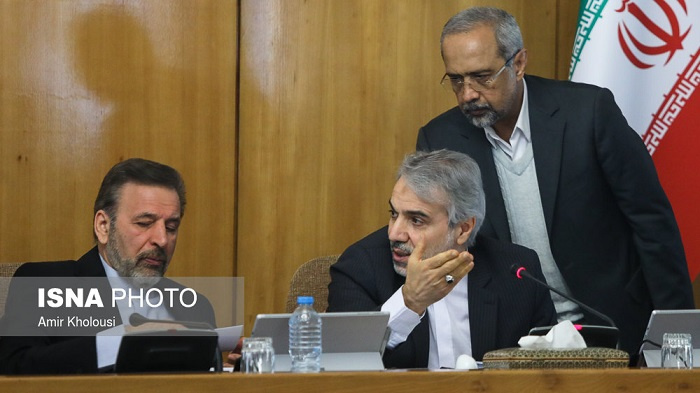The ‘Clique Grice’ and the Future of Hassan Rouhani

(From right: Nahavandian, Nobakht, and Vaezi in a cabinet meeting.)
“It feels like Mr Rouhani has abandoned the country’s affairs”. These words were not uttered by Rouhani’s fierce opponents in the Principlist camp, but Faezeh Hashemi, the outspoken daughter of the late Akbar Hashemi Rafsanjani, and a supporter of the moderate president.
Her remarks, published in Financial Times, may not tally with truth completely, but they certainly represent a common feeling among the Reformist supporters of Rouhani government in a critical juncture. Reformists agree with Rouhani’s hardliner critics over at least one issue: that the 69-year old president has to take the painful, but necessary step and carry out a ‘surgery’ on his cabinet.
The ‘clique grice’
The government’s decision to lower interest rates to 15 percent and the ensuing liquidity chaos, exacerbated by Trump’s decision to withdraw from the JCPOA and its psychological impacts, have dampened the mood of the Iranian economy. Surprisingly, in his recent meeting with the commentariat Rouhani attributed the new negative vibe not to material disturbances in the Iranian economy, but to media coverage, a conviction Reformists can hardly agree with.
A few days later, at the height of economic angst and rising prices, a picture went viral in the Iranian media, showing President Hassan Rouhani going for a hike at Tehran’s northern mountains, smiling and donning a Puma cap. That such a picture is published amid such circumstances is a clear sign how far chief-of-staff Mahmoud Vaezi, Rouhani’s closest confidante, is from a media-savvy. Vaezi is not the only Iranian politician ignorant of the powerful messages media can convey, but his significant influence over Hassan Rouhani’s policies make the issue important. Media reaction would even hold little importance if the government had taken tangible, effective actions to alleviate economic concerns of the average Iranian citizen, and help them have no worries while shopping in a supermarket.
The price of gold and dollar skyrocketing in Tehran, increasing psychological pressure on Iranians, Massoud Karbasian, Minister of Economy and the favorite choice of Mohammad-Bagher Nobakht and Mohammad Nahavandian, two other members of Rouhani’s inner circle, appears nonchalant, claiming that “everything is fine and we have no economic problems”. This single remarks proves how nothing is fine with the government and how the cabinet suffers serious structural deficiencies.
Chief-of-staff Vaezi has also relayed plans to split a number of ministerial portfolios to streamline their governance. It is open to discussion how adding the number of ministries and creating a larger cabinet can tackle inefficient policies of the government.
On Sunday, June 24th, following a spike in the price of imported cell phones [which led to a strike in cell phone markets in Tehran], Mohammad-Javad Azari Jahromi, the sole young minister in Rouhani’s cabinet, promised to disclose the name of ‘rentiers’, i.e. those who had imported the cell phones thanks to dollars they had received from the government with a low exchange rate. He materialized his promise in 8 hours and revealed the names, showing how the importers had enjoyed the gap between the exchange rate difference between government-supplied dollar and the free market dollar. Such decisive actions should be the norm in Rouhani’s economic cabinet, but few can claim so. As Parvaneh Mafi, female Reformist MP from Tehran, has said: while Jahromi personally attends among the vendors in Tehran’s cell phone market to disclose the name of the rentier companies and ease tensions, the economic team of the cabinet seems to be in sweet dreams. Mafi is one of those who has called for a reshuffle in the cabinet.
Massive changes in the government look unlikely however. It seems that Rouhani is surrounded and influenced by a few close members of the cabinet, and he can’t be accessed unless via these ‘gatekeepers’. This inner circle, the ‘clique grice’, includes Mahmoud Vaezi, Mohammad-Bagher Nobakht (spokesman of the government), and Mohammad Nahavandian, Vice President for Economic Affairs; figures who are neither Principlist nor Reformist, having shown several about-faces in their political life. Their common denominator seems to be making the most of their days in the height of power. The trio seems unmotivated to solve the problems the country is facing, and is making the characteristically conservative Rouhani even more conservative. With such an inner circle and their ineffective policies which will eventually strip Rouhani off his social base, can the president envision a powerful post-presidency role as he wishes? Only time will tell.
* This is a free translation of an original piece published in Aftab-e Yazd, a Reformist daily newspaper. Additions and omissions have taken place to make it more readable for the English language audience.

